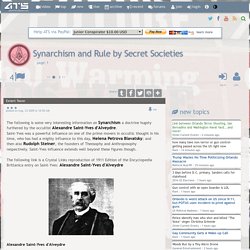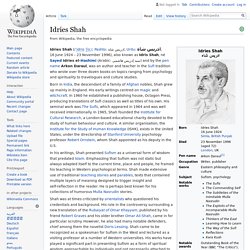

Noosphere. The Phenomenon of Man. The Phenomenon of Man (Le phénomène humain, 1955) is a book written by the French philosopher, paleontologist and Jesuit priest Pierre Teilhard de Chardin.

Synarchism and Rule by Secret Societies, page 1. Partly this is to fit the pronouncements of the American psychic Edgar Cayce (1877-1945), who said that the Sphinx and Pyramids were built by survivors from Atlantis in 10500 BC.

But it also fits the view of history used to justify another, very specific - and in our view very alarming - form of occult philosophy. To understand this we have to go back to 19th century France, and a political-occult ideology called Synarchy. The New Order Begins In Britain, Synarchy is not widely known even among those interested in esoteric movements and secret societies. This is very surprising, as Synarchy and its founder have been extraordinarily influential. Joseph Alexander Saint-Yves d'Alveydre Synarchy was founded in the early 1870s by Joseph Alexander Saint-Yves d'Alveydre (1824-1909). Isma'ilism. Branch of Shia Islam Ismailism rose at one point to become the largest branch of Shīʻism, climaxing as a political power with the Fatimid Caliphate in the tenth through twelfth centuries.[4] Ismailis believe in the oneness of God, as well as the closing of divine revelation with Muhammad, whom they see as "the final Prophet and Messenger of God to all humanity".

The Ismāʿīlī and the Twelvers both accept the same initial Imams. Ismaili thought is heavily influenced by neoplatonism.[6][7] Though there are several paths (tariqat) within Ismailism, the term in today's vernacular generally refers to the Nizaris, who recognize Aga Khan IV[8] as the 49th hereditary Imam and are the largest Ismaili group. History[edit] Succession crisis[edit] Ismailism shares its beginnings with other early Shiʻi sects that emerged during the succession crisis that spread throughout the early Muslim community. Karbala and afterward[edit] Idries Shah - claimed rosecruscianism came from Sufis (predating islam) Idries Shah (/ˈɪdrɪs ˈʃɑː/; Pashto: ادريس شاه, Urdu: ادریس شاه; 16 June 1924 – 23 November 1996), also known as Idris Shah, né Sayed Idries el-Hashimi (Arabic: سيد إدريس هاشمي) and by the pen name Arkon Daraul, was an author and teacher in the Sufi tradition who wrote over three dozen books on topics ranging from psychology and spirituality to travelogues and culture studies.

In his writings, Shah presented Sufism as a universal form of wisdom that predated Islam. Emphasizing that Sufism was not static but always adapted itself to the current time, place and people, he framed his teaching in Western psychological terms. Shah made extensive use of traditional teaching stories and parables, texts that contained multiple layers of meaning designed to trigger insight and self-reflection in the reader. He is perhaps best known for his collections of humorous Mulla Nasrudin stories. Shah was at times criticized by orientalists who questioned his credentials and background.
Life[edit] Karl Haushofer - Thule soc., Vrill soc, Hitlers master; see Gurgiev & Sufism & Dali Lama. Karl Ernst Haushofer (27 August 1869 – 10 March 1946) was a German general, geographer and geopolitician.

Through his student Rudolf Hess, Haushofer's ideas influenced the development of Adolf Hitler's expansionist strategies, although Haushofer denied direct influence on the Nazi regime. Under the Nuremberg Laws, Haushofer's wife and children were categorized as mischlinge. His son, Albrecht, was issued a German Blood Certificate through the help of Hess. Life and career[edit] Haushofer belonged to a family of artists and scholars. Occult Secrets of the Dalai Lama. Shambhala As reported by Tim Cummings in The Guardian, the man credited with “almost single-handedly bringing Tibetan Buddhism to the West,” was the Dalai Lama's emissary, Gerald Yorke, a personal friend and secretary to Aleister Crowley, the godfather of twentieth century Satanism.[1] Yorke also wrote an original foreword to a secret book on the Kalachakra initiation, and Aleister Crowley, the Golden Dawn, and Buddhism.

Yorke also served as consultant to Lucifer Rising, by experimental film-maker Kenneth Anger, based on the concept from Crowley’s Book of the Law. Rosicrucian connections. The Shadow of Solomon: The Lost Secret of the Freemasons Revealed by Laurence Gardner - Reviews, Discussion, Bookclubs, Lists. Symbols in books of alchemy. Sources: Wd1426, Wd1421A, Wv149, Ws2541A Wd1426, a book of alchemical recipes, has caused us to add some additional symbols to our inventory of character entities: signs for substances antimony and sal armoniac; the elements fire and water; and the syllabics "subli-" and "precipi-" (found in sublimate, precipitate, etc.).

We've also gone ahead and added the elemental symbol for earth, on the assumption that it will eventually appear in our books as well. The new symbols will soon (March 2002) appear in the latest online version of the primary keying instructions as reproduced below.